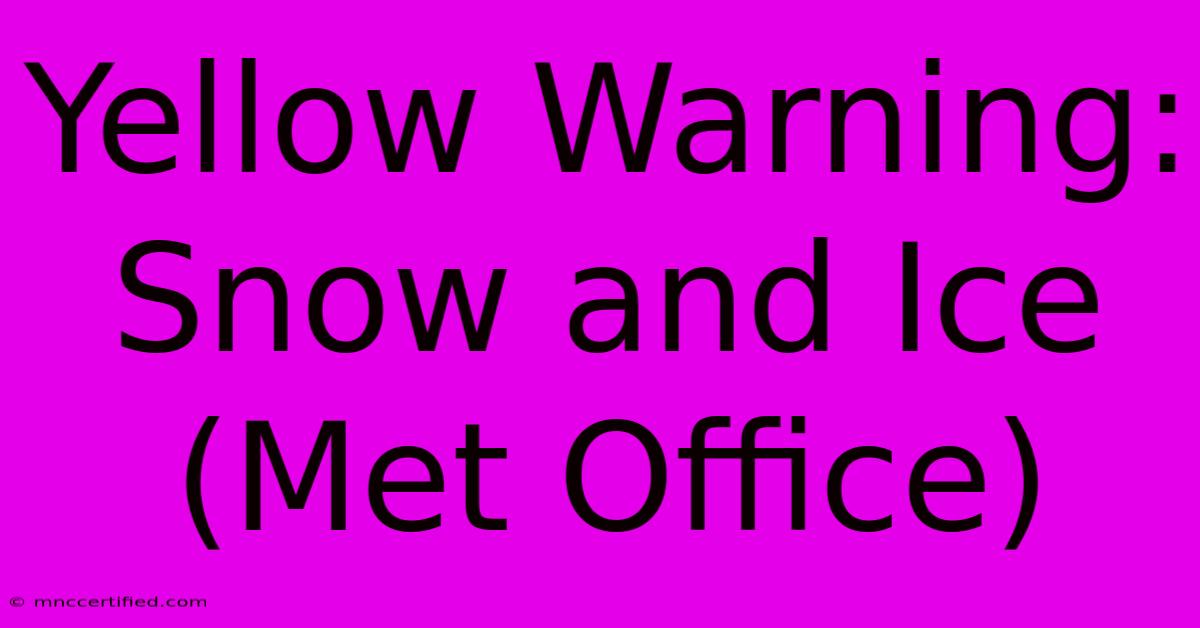Yellow Warning: Snow And Ice (Met Office)

Table of Contents
Yellow Warning: Snow and Ice (Met Office) – What You Need to Know
The Met Office issuing a Yellow Warning for snow and ice means potential disruption is on the way. This isn't a cause for immediate panic, but it's a crucial signal to prepare and stay informed. This article will guide you through understanding what a Yellow Warning signifies, how to prepare for potential snow and ice, and where to find the most up-to-date information from the Met Office.
Understanding the Met Office Yellow Warning System
The Met Office uses a colour-coded warning system to communicate the severity of weather events. A Yellow Warning for snow and ice indicates that some disruption to travel and daily activities is likely. This means you should be aware of the potential hazards and take appropriate precautions. It's a step below an Amber Warning (be prepared) and a Red Warning (take action). While a Yellow Warning doesn't necessarily mean severe weather will impact everyone, it's a heads-up to be prepared for potential problems.
Key Implications of a Yellow Warning for Snow and Ice:
- Travel Disruptions: Expect potential delays and cancellations to road, rail, air, and sea travel. Driving conditions may become hazardous.
- Power Outages: Heavy snowfall or freezing rain can damage power lines, leading to temporary power cuts.
- Injuries: Slips, trips, and falls are more likely on icy surfaces.
- Disruption to Daily Life: Schools may close, and some businesses may experience delays or closures.
How to Prepare for Snow and Ice During a Yellow Warning
Preparation is key to minimizing disruption during a Yellow Warning. Here’s a checklist:
- Check the forecast regularly: Stay updated on the Met Office website or app for the latest information and warnings specific to your area. Knowing the timing and intensity of the expected snowfall will allow for better planning.
- Prepare your vehicle: Check your antifreeze levels, ensure your windscreen wipers are in good condition, and pack a winter survival kit including blankets, warm clothes, food, water, and a shovel. Consider carrying tire chains if driving in areas prone to heavy snowfall.
- Stock up on essentials: Ensure you have enough food, water, and medications to last for a few days in case of power outages or travel disruptions.
- Prepare your home: Check your heating system and ensure you have adequate insulation. Clear gutters and drains to prevent ice build-up.
- Inform vulnerable neighbours: Check on elderly or vulnerable neighbours and offer assistance if needed.
- Dress warmly: Wear layers of clothing to stay warm if venturing outdoors. Wear appropriate footwear with good grip to avoid slips and falls.
- Charge your devices: Ensure your phone and other electronic devices are fully charged in case of power outages.
Finding the Latest Met Office Information
The Met Office is the official source for weather information in the UK. To stay informed during a Yellow Warning (or any weather warning), consult these resources:
- Met Office Website: The official website provides detailed forecasts, warnings, and weather charts.
- Met Office App: Download the Met Office app for real-time updates and alerts directly to your mobile device.
- Social Media: Follow the Met Office on social media platforms for timely updates and information.
- Local News: Check your local news channels and websites for updates specific to your region.
Key Takeaways: Don't Underestimate a Yellow Warning
While a Yellow Warning doesn't signify the most extreme weather conditions, it's crucial to take it seriously. By following the advice above and staying informed, you can significantly reduce the risk of disruption and stay safe during periods of snow and ice. Remember, preparation is your best defense against the unexpected. Being proactive is far better than reacting to a crisis. Stay safe and stay informed!

Thank you for visiting our website wich cover about Yellow Warning: Snow And Ice (Met Office). We hope the information provided has been useful to you. Feel free to contact us if you have any questions or need further assistance. See you next time and dont miss to bookmark.
Featured Posts
-
Watch Lsu Vs Florida Football
Nov 17, 2024
-
Do Vets Have Malpractice Insurance
Nov 17, 2024
-
Ufc 309 Complete Fight Results Announced
Nov 17, 2024
-
West Indies Bowl First Turners Debut
Nov 17, 2024
-
Ohio State Vs Northwestern Live Stream 11 16 24
Nov 17, 2024